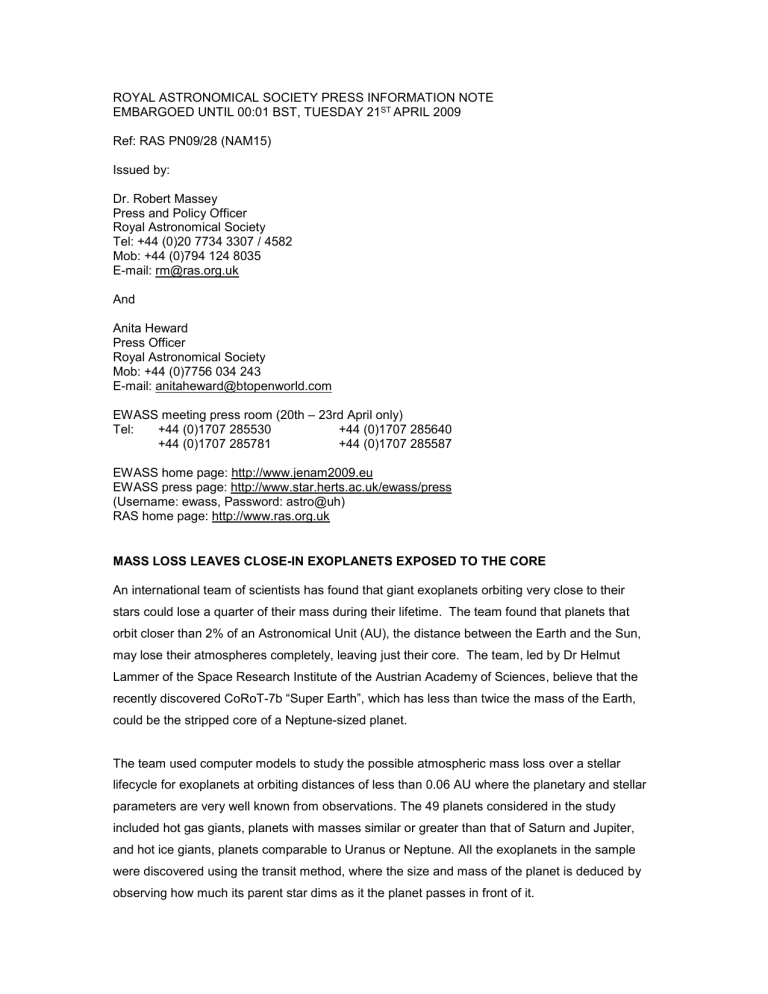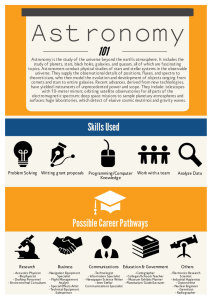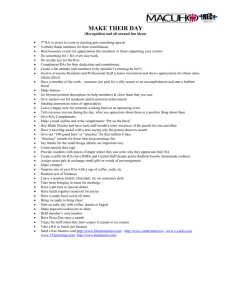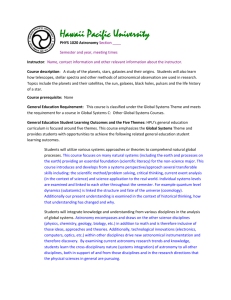Lammer_final - University of Hertfordshire

ROYAL ASTRONOMICAL SOCIETY PRESS INFORMATION NOTE
EMBARGOED UNTIL 00:01 BST, TUESDAY 21 ST APRIL 2009
Ref: RAS PN09/28 (NAM15)
Issued by:
Dr. Robert Massey
Press and Policy Officer
Royal Astronomical Society
Tel: +44 (0)20 7734 3307 / 4582
Mob: +44 (0)794 124 8035
E-mail: rm@ras.org.uk
And
Anita Heward
Press Officer
Royal Astronomical Society
Mob: +44 (0)7756 034 243
E-mail: anitaheward@btopenworld.com
EWASS meeting press room (20th – 23rd April only)
Tel: +44 (0)1707 285530
+44 (0)1707 285781
+44 (0)1707 285640
+44 (0)1707 285587
EWASS home page: http://www.jenam2009.eu
EWASS press page: http://www.star.herts.ac.uk/ewass/press
(Username: ewass, Password: astro@uh)
RAS home page: http://www.ras.org.uk
MASS LOSS LEAVES CLOSE-IN EXOPLANETS EXPOSED TO THE CORE
An international team of scientists has found that giant exoplanets orbiting very close to their stars could lose a quarter of their mass during their lifetime. The team found that planets that orbit closer than 2% of an Astronomical Unit (AU), the distance between the Earth and the Sun, may lose their atmospheres completely, leaving just their core. The team, led by Dr Helmut
Lammer of the Space Research Institute of the Austrian Academy of Sciences, believe that the recently discovered CoRoT7b “Super Earth”, which has less than twice the mass of the Earth, could be the stripped core of a Neptune-sized planet.
The team used computer models to study the possible atmospheric mass loss over a stellar lifecycle for exoplanets at orbiting distances of less than 0.06 AU where the planetary and stellar parameters are very well known from observations. The 49 planets considered in the study included hot gas giants, planets with masses similar or greater than that of Saturn and Jupiter, and hot ice giants, planets comparable to Uranus or Neptune. All the exoplanets in the sample were discovered using the transit method, where the size and mass of the planet is deduced by observing how much its parent star dims as it the planet passes in front of it.
“If the transit data are accurate, these results have great relevance for planetary formation theories”, said Dr Lammer, who is presenting results at the European Week of Astronomy and
Space Science at the University of Hertfordshire.
“We found that the Jupiter-type gas giant WASP-12b may have lost around 20-25% of its mass over its lifetime, but that other exoplanets in our sample had negligible mass loss. Our model shows also that one major important effect is the balance between the pressure from the electrically charged layer of the planet’s atmosphere and the pressure from the stellar wind and coronal mass ejections (CMEs). At orbits closer than 0.02 AU, the CMEs – violent explosions from the star’s outer layers – overwhelm the exoplanet’s atmospheric pressure causing it to lose maybe several tens of percent of its initial mass during its lifetime .”
The team found that gas giants could evaporate down to their core size if they orbit closer than
0.015 AU. Lower-density ice giants could completely lose their hydrogen envelope at 0.045 AU.
Gas giants orbiting at more than 0.02 AU lost about 5-7% of their mass. Other exoplanets lost less than 2%. Results suggest that CoRoT-7b could be an evaporated Neptune-like planet but not the core of a larger gas giant. Model simulations indicate that larger mass gas giants could not have been evaporated to the mass range determined for CoRoT-7b.
NOTES FOR EDITORS
THE EUROPEAN WEEK OF ASTRONOMY AND SPACE SCIENCE
More than 1000 astronomers and space scientists will gather at the University of Hertfordshire for the European Week of Astronomy and Space Science (EWASS), incorporating the 2009 Royal
Astronomical Society National Astronomy Meeting (RAS NAM 2009) and the European
Astronomical Society Joint Meeting (JENAM 2009). The meeting runs from 20th to 23rd April
2009.
EWASS is held in conjunction with the UK Solar Physics (UKSP) and Magnetosphere Ionosphere and Solar-Terrestrial Physics (MIST) meetings. The conference includes scientific sessions organised by the European Organisation for Astronomical Research in the Southern Hemisphere
(ESO) and the European Space Agency (ESA).
EWASS is principally sponsored by the Royal Astronomical Society (RAS), the Science and
Technology Facilities Council (STFC) and the University of Hertfordshire, Hatfield.
THE ROYAL ASTRONOMICAL SOCIETY
The Royal Astronomical Society (RAS), founded in 1820, encourages and promotes the study of astronomy, solar-system science, geophysics and closely related branches of science. The RAS organizes scientific meetings, publishes international research and review journals, recognizes outstanding achievements by the award of medals and prizes, maintains an extensive library, supports education through grants and outreach activities and represents UK astronomy nationally and internationally. Its more than 3000 members (Fellows), a third based overseas, include scientific researchers in universities, observatories and laboratories as well as historians of astronomy and others.
IMAGES
Artist’s impressions of an evaporating gas giant can be found at: http://www.esa.int/esaCP/SEMD5P2A6BD_index_1.html
CONTACTS
Mag. Dr. Helmut Lammer
Space Research Institute
Austrian Academy of Sciences
Schmiedlstr. 6
A-8042, Graz
Austria
Phone: 0043 316 4120 641
Fax: 0043 316 4120 690
E-mail: helmut.lammer@oeaw.ac.at







